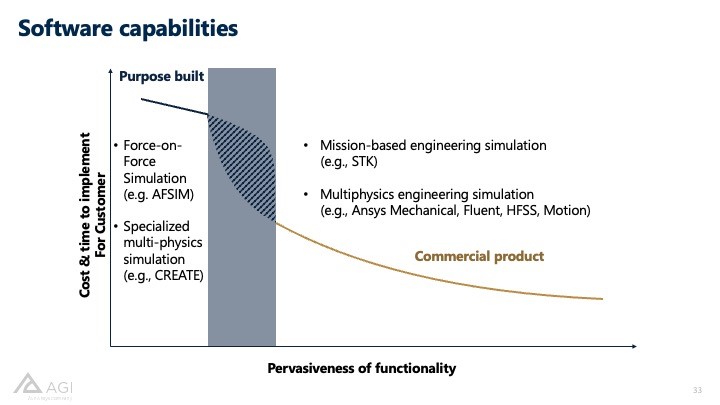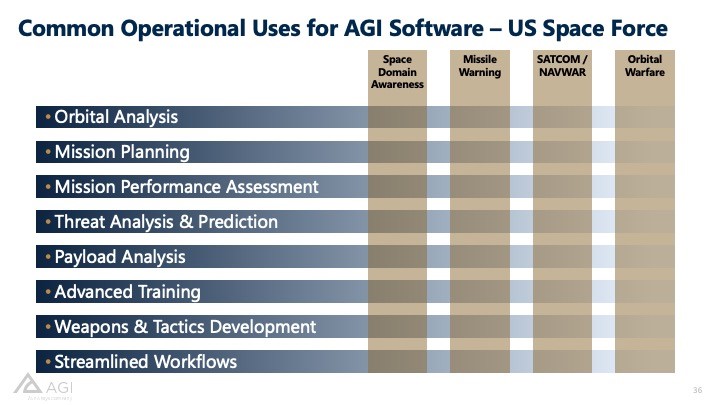AGI, An Ansys Company, Hosts Crossflow Event with Military Fellows
- Jun 21, 2021
- Blog Post
-
 Orbit Determination Tool Kit (ODTK)
Orbit Determination Tool Kit (ODTK)
AGI hosted the first hybrid virtual and in-person Crossflow event, experiences where fellows host their classmates for in-depth tours, since the pandemic started. Air Force Education with Industry (EWI) and Army Training with Industry (TWI) fellows embedded at AGI set up the hybrid event to showcase their fellowship experience, highlight AGI’s critical role in digital engineering, and provide firsthand experience walking through operational use cases and product demonstrations.

Left to right; CPT. Bryce Thornton (Army TWI at AGI), Capt. Roman Tillman (USSF EWI at Google), Capt. Alexis Sanchez-Martinez (USSF EWI at Space-X), Capt. Bryan Foster (USSF EWI at Virgin Orbit), Capt. Kyle Futch (USSF EWI at Millennium Space Systems), Lt. Josh Tarrant (USAF EWI at AGI), Josh Reicher (AGI Senior Engineer & EWI/TWI Company Coordinator)
Lt. Josh Tarrant, Air Force EWI, and CPT. Bryce Thornton, Army TWI, hosted four United States Space Force captains currently working fellowships with Millennium Space Systems, Space-X, Virgin Orbit, and Google. Plus, over 45 Air Force, Army, and Space Force fellows from the current year and following year, as well as program leadership attended virtually. Space Force Captain Kyle Futch, engineer and EWI fellow at Millennium Space Systems, said the following about attending the first hybrid Crossflow in-person, “The experience AGI provided to USSF Officer Fellows at the EWI Crossflow was top-notch. Not only does the team at AGI understand the value of fostering relationships between the government and civilian sector, but they stand proud behind their work and allow the software to ‘speak for itself’ as all software should. As a force, we have much to gain through collaborative relationships with companies like AGI which leverage cutting edge technologies into intuitive, reliable, and intelligent applications to further propel our National Defense Strategy.”
The event opened with Steven J. Bleymaier, Ansys Vice President of Global Strategy and Government Programs, Aerospace and Defense at Ansys, and Air Force Brigadier General (retired). Gen. Bleymaier focused on the fellows’ value to industry partnerships, value to the Department of Defense (DoD) and respective military service branches, and the EWI/TWI programs value to each fellow. As a highly successful aircraft maintenance and logistics officer, he closed with thoughts on leadership and referred to several readings and methods.
AGI CEO and Co-Founder Paul Graziani provided a company overview and his thoughts on the programs. He said, “We are thrilled to host both the Army TWI and Air Force EWI fellows here at our headquarters, and we can’t wait to continue the program with the Space Force. Lt Josh Tarrant, our second EWI fellow, will transition to the Space Force spring 2021 and we are excited for this historic event AGI has worked closely with the service departments throughout our 32-year history, and our products and services help the national security community perform their critical mission.”
Space Force Captain Bryan Foster, visiting AGI in person from his EWI fellowship with Virgin Orbit, stated, “The trip to AGI was an excellent experience. It provided a much deeper understanding of how the STK application, which is used in the GPS control center and across a number of other Air Force programs, actually works and supplies critical data used by the space warfighters every day. Additionally, the briefings given by the AGI senior leadership and engineers gave insight into how the use of digital engineering tools could be used to design and maintain systems vastly more efficiently which supports DoD policy of accelerating development without sacrificing quality.” Foster goes on to say, “the corporate culture of AGI was a model that should be reflected in units across the Air Force. By making every member of their team feel important, invested in the product, and recognized for their contributions they have created an environment that no one wants to leave. Engendering that kind of camaraderie and dedication through recognition and product ownership is essential to getting the most out of program teams in the Air Force and keeping the highly trained individuals in our ranks from looking elsewhere when their service commitments are up.”
Kevin Flood, AGI’s vice president of engineering, discussed digital mission engineering and digital mission operations in depth, and highlighted the revolutionary change that can be unlocked through DoD and commercial partnerships related to engineering simulation software. Kevin said, “commercial products will always deliver capabilities faster, cheaper, and better because product companies invest ahead of requirements, synthesize the needs of broad swaths of customers, and amortize costs across a wide range of users.” The chart below speaks to the curve of time and cost versus functionality of software. Kevin went on to say, “there will be some important specialized needs that commercial products won't address because the need isn't broad enough, which will require purpose-built products. But, those should focus only on the incremental capability required to augment state-of-the-art commercial products to maximize value to the warfighter. What is needed is a better collaboration between DoD and commercial product companies to take advantage of relative strengths. Concerns such as price of commercial products, need to control the source code, and being beholden to a particular vendor can all be overcome with sound partnering.”

CPT. Bryce Thornton, TWI Fellow, stated, “The event was a first time an Army TWI Officer was able to showcase what they have accomplished to a larger audience. One highlight was the ability to bring back some TWI alumni. Colonel Kenneth Klock and Lieutenant Colonel Craig Boucher shared their thoughts and impressions from their time at AGI and how it has help continue their military success.”
Jason Ruggieri, DoD business development lead at AGI, briefed operational use cases, showing real world challenges and the relevance of AGI’s Systems Took Kit (STK), a physics-based modeling and simulation software platform for sea, land, air, and space. Space Force operators and educators use STK for a variety of functions, as seen here:

Guest speaker, Mr. Jeffery Harris, spoke on his storied career as a prominent figure in U.S. national security history, going over his career in multiple senior level positions. He discussed how he was able to help foster new technology, capabilities, and programs during his time as director of the National Reconnaissance Office (NRO)and Assistant Secretary of the Air Force for Space. He finished off his discussion with advice on how younger officers could be successful in the growing space domain.
The event was rounded out by AGI’s EWI/TWI company coordinator, Josh Reicher, who provided an overview of the entire life cycle of systems using digital twins. You can see a recorded version of his briefing here: Evolution of Digital Twins – Webinar.
Space-X Fellow, Captain Alexis Sanchez-Martinez said, “I really enjoyed getting the opportunity to go to AGI in person. I love how AGI is a relatively small company with a passion for their customers as well as their employees. The software they provide has endless utilization and I look forward to incorporating STK into my personal “tool kit” after being introduced to several of the operational use cases.” Before the training class, Capt. Sanchez-Martinez and others completed the STK Level 1 Certification, which she said, “really helped me get background on the construct of STK, furthering my understanding of the briefing material and capabilities the suite of software can provide.” Anyone can take the free training and get certified on our training page.
